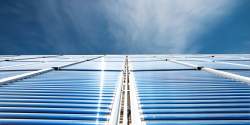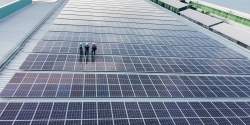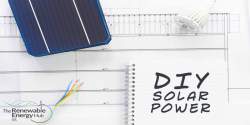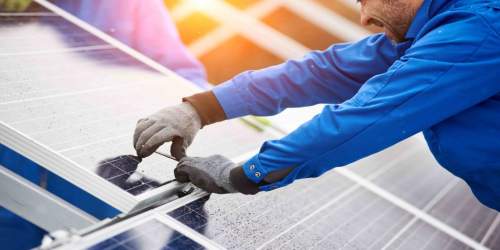Read Time : 5 Minutes
Commercial Solar PV - A Comprehensive Guide
Why Commercial Solar?
As with all solar power options, using the renewable energy of the sun to power your business has many advantages. These benefits are:
- Lower energy bills
- Show your commitment to renewable energy
- Lower CO2 emissions and a smaller carbon footprint
- Increased revenue from the sale of surplus power
- Make more use of effective space.
- Less reliance on energy providers, price hikes, and failing infrastructure
- Subsidies, grants, and tax breaks
- Improved public relations
Lower bills
Saving money on your outgoings is a zero-brainer. Switching to solar energy can save you up to 70% on your current energy bills. In the UK, the average return on investment for a solar system is about 10 years. If you shop well though, and have a good location for your system, it’s possible to reduce that time frame by a few years.
COMPARE PRICES FROM LOCAL INSTALLERS
Compare prices from local companies fast & free
Enter your postcode to compare quotes from leading professionals. We promise to keep your information Safe & Secure. Privacy Policy
Demonstrating your commitment to renewable energy
We’re taking the moral high ground here, but if the planet matters to you then a show of solidarity is a great way to stand behind climate action.
Lower C02 emissions and a smaller carbon footprint
Staying on the moral highway for now, switching to solar is a solid way to reduce your carbon footprint and your C02 emissions. There are a few other incentives to do this too, but we’ll get to those in a mo.
Increased revenue from the sale of surplus power
Back on the business side of the ledger, switching to solar could open new revenue streams for your business. There are government incentives that guarantee to buy back your surplus power. How much you earn though comes down to several factors. Elements like the size and efficiency of your system, how much you paid for it, and which tariff you opt for, all affect the numbers.
Make more use of effective space
Depending on the amount of roof space you have you may decide to install a bigger system with the sole intention of generating more income. There’s no limit to the energy you can sell back to the grid. So, if you have ample effective roof space, enough cashflow, and shrewd negotiating skills, why not invest more in solar?
Less reliance on energy providers, price hikes, and failing infrastructure
Generating your own power frees you from traditional energy providers and all their palaver. No need to worry about power cuts and brownouts, and better yet they can’t hold you to ransom with their ever-spiralling prices. It’s also worth wondering how the current providers will cope with an aging national grid as we head toward a renewable future. Let’s be honest when the big repair bill comes, we know how they’re going to fund it.
Current incentives and subsidies
One major advantage of switching your business to solar power is the large number of initiatives available to help cover the costs. These schemes and projects fall into five groups:
- Local authority
- National government
- Energy providers
- NGOs, social enterprises, commercial enterprises, and non-profit organisations
- Commercial businesses
We’ll look at each in turn
Local authority
Most councils have schemes to help small and medium-sized businesses become more energy efficient. This often includes funds to make the switch to solar. For example, there’s an initiative in the Home Counties called Low Carbon Workspaces. This scheme offers qualifying businesses grants to improve their energy efficiency. Awards range between £1000 and £6750. As we mentioned above, many different councils run similar programs. So, before getting the company credit card out, it’s worth checking with your local authority. They’ll tell you what help, if any, is available. You can check here.
National government programs
Like local authorities, the UK government runs initiatives to help companies improve energy efficiency. These programs change often, so it’s a good idea to check out the latest updates to find out what programs are available. As well as grants, loans, and other funding options they also run longer-term incentives. These nationwide programs help UK businesses shoulder the cost of solar. These schemes include:
The Smart Export Guarantee (SEG)
SEG is a commitment to buy excess energy generated by private solar systems. SEG is the replacement for the government’s Feed in Tariff (FIT). FIT, although closed to new applications is a popular scheme still running today. Unlike SEG, FIT also paid private solar owners for all the energy they generated.
The Industrial Energy Transformation Fund (IETF)
The Department for Energy Security and Net Zero and the Department for Dusiness, Energy and Industrial Strategy have been alloted almost £5 billion to provide funding to UK businesses in the drive to become greener. The initiative is designed to progress the UK commitment to reach net zero emissions by 2050.
Funding will be provided to businesses investing in green technologies.
Phase 2 is currently closed to new applications but in March 2023 IETF phase 3 was announced with £185m available for funding businesses looking to invest in green tech.
The Consultations section below contains a link to a consultation on the design of the new phase. We plan to launch IETF Phase 3 in early 2024.
For more information about the IETF and the application process contact ietf@beis.gov.uk.
If your site is based in Scotland, you can apply for the Scottish Industrial Energy Transformation Fund (SIETF), or contact them at IETF@gov.scot.
ZERO VAT Commitment
This scheme waives VAT on the installation of solar energy systems. It’s worth noting the fine print though when applying for this scheme. In simple terms, it only covers solar storage/batteries if they’re installed as part of a system. Batteries added later will not count and VAT is still applicable.
ECO4 and LAFLEX
The Energy Company Obligation is now in its fourth iteration hence ECO4. ECO is a government project to help cover the costs of solar installations and LAFLEX is a local authority amendment. LAFLEX plugs the many gaps in the scheme when it became obvious the government had set the acceptance criteria too high. Taking the form of a loan, this scheme is about as opaque as it gets. It began life as a joint venture between the UK government and the big energy providers. It still operates in theory, but its glory days are behind it.
Energy providers
What, if any, help you can get from your energy provider depends a great deal on who your provider is. Most providers can provide some assistance though even if it’s only as part of the ECO4 program. How much help you’ll get comes down to which company provides your power. You can check out who your energy provider is here.
Non-profits, NGOs, Quangos, and charities
In addition to governmental aid and help from energy providers, there’s a raft of third parties eager to assist. These organisations tend to hail from the non-profit sectors. They include NGOs, social enterprises, environmental action groups, and charities. Grants, loans, and advice are all options depending on where you live and how much research you put in.
Here are a few examples of the programs and the Organisations that offer them:
Energy Redress Fund: a multi-million-pound fund open to CVS, CICs, and Co-operatives to help them reduce emissions.
Baywind Energy Co-operative Ltd: this organisation has a £1 million fund and is out there looking for solar and hydro sites to support.
Green Heat Network Funding: a capital grant-supported program. The Green Heat Network helps develop new and improve existing zero-carbon heat systems.
Commercial entities
As we mentioned above PR is one of the big incentives for switching to commercial solar power. This could explain why some commercial entities even provide funding for renewable projects. Now, it’s important to mention that these funds likely have higher bars than other options. To tell the truth, you’d be lucky to get a penny out of them for a standard solar panel array for your shop. That said, if you can find a good angle, there’s millions in free money out there. A few of these organisations offer grants and funding. They include leading outdoor brand Patagonia, insurance giants Aviva, and the National Lottery which has a £10M pool for renewable energy projects.
Improved public relations
As we discussed, some companies are so invested in the renewable energy PR boom, they’re pouring their own cash in to set up funds. For the rest of us smaller concerns though, there’s still plenty of PR mileage to be had for switching to solar power. In this the Information Age, never has the world been smaller, faster, or more climate conscious. Today, consumers operate in a near-Darwinian fashion. To survive in such a sustainability-focussed market we all need clear, bold, and climate-focussed policies. If not, we run the risk of our customers voting with their feet and their bank balances.
Conclusion
There are many advantages for businesses that choose to install solar PV. Solar power provides a cost-effective solution for companies seeking to reduce their energy consumption. Solar PV can maximise efficiency for businesses of all sizes.
As well as the considerable cost savings to be made, installing solar PV also gives companies the opportunity to play a role in helping to reach climate change targets and reduce their carbon footprint. It also helps to promote the company’s commitment towards green energy sources, improving public image and making them environmentally responsible, it can enhance corporate reputation. This will appeal to a wider customer base as there is a growing consumer demand for energy saving and carbon reducing products and services.
Commercial solar panels ensure a reliable energy supply for 25 years or more due to their durability and low maintenance requirements. Over time it has become very clear that solar energy can protect businesses from the volatility of energy markets by giving them energy independence.
With the recent increase in the cost of electricity the payback period for solar PV has become considerably shorter which makes installing solar PV a smart long-term financial investment. Pay-back periods can be as short as five years, with substantial returns possible on your initial investment over the lifespan of the system. Furthermore, there is always the potential for government incentives and grants.
By installing solar panels, companies can lead the way in the renewable revolution, while securing a bright and sustainable future for generations to come.
Find a local installer
Welcome to the biggest directory of UK renewable energy companies






 How Much do Solar Panel Systems Cost in 2024?
How Much do Solar Panel Systems Cost in 2024?







